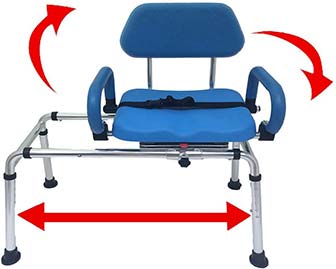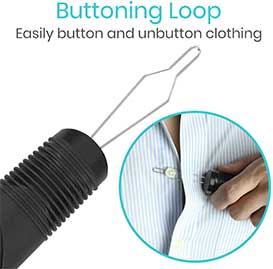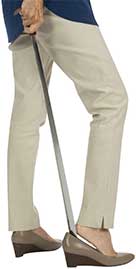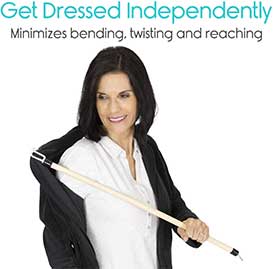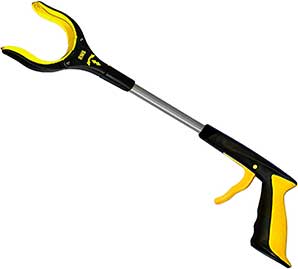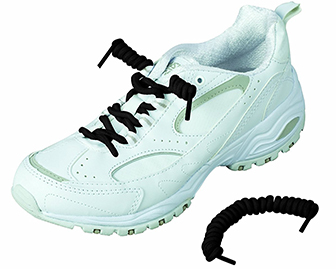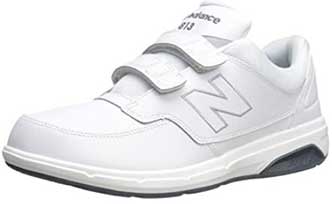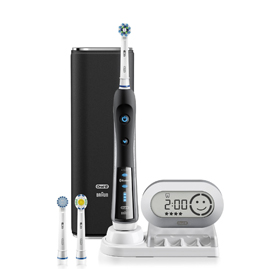With advanced age, the body is not as physically strong and flexible. Moreover, muscle weakness is common amongst the elderly with poor stamina and low energy levels limiting the activities that they can complete on their own.
This article will highlight some common old age problems and solutions that can help seniors live independently.
What Do The Elderly Struggle With
Due to old age, chronic health conditions, side effects from medication, seniors can have trouble with the following activities:
Bathing and shower transfers
Getting into and out of the shower or bathtub, also known as a transfer, can be difficult for many seniors.
One potential issue is that the bathtub wall is too high to easily lift their legs over the edge. Another common problem is that the floor may be slippery when wet. Together these conditions can contribute to a fall and potential injury.
To make the bathroom more senior friendly, safety devices can be obtained to make bathing easier and transfers more safe.
The following items are commonly found in a senior’s bathroom:
- Bath chair with backrest – sit and rest on this chair while showering
- Tub transfer bench – can be used to slide into the bathtub more easily to have a shower from a seated position
- Flexible long cord shower hose – best used when having a seated shower to rinse and wash different parts of the body
- Tub railing – clamps onto the side of the bathtub and can be held for support with stepping in and out
- Grab bars – installed into the adjacent walls of the tub or shower and used for support with transfers or balance
- Non-slip bath mat and shower pad – placed on the floor of the shower or bathtub, this non-slip surface reduces the risk of falling
Dressing and changing clothes
Bending over to put on shoes or socks, manipulating small buttons to put on a shirt, and pulling pants up to dress can be a common struggle for the elderly.
These challenges can be due to poor balance, difficulty with fine motor dexterity, and joint pain that limits range of motion.
To overcome these dressing difficulties, someone can rely on caregiver support or use assistive aids to achieve modified independence.
The following dressing aids can be used by a senior to achieve greater self reliance:
- Button aid with zipper hook – used to grasp small buttons to pull them through the buttonhole and has a hook that helps to pull zippers up or down
- Long handled shoe horn – helps to put on shoes without needing to bend over
- Dressing stick – helps with pulling clothes onto the body and undressing by pushing clothes that are hooked onto the prong away from the body
- Grasping reacher – hand held extending tool that grabs items such as socks off the floor or clothing from high closets
- Elastic laces – used to secure shoes without needing to bend over or tie laces
- Velcro shoes – secure footwear without needing to tie string laces
Bladder and bowel control
Walking difficulty can be troublesome for many seniors. When this is combined with an urgency to empty the bladder or defecate, it can be a recipe for an accident on the way to the bathroom.
On top of this, many elderly individuals suffer from poor bladder and bowel control, and can have episodes of incontinence. The frequency of these incidents can be worsened if there is an underlying medical condition like an enlarged prostate, history of bowel disease or medication side effects that alter the transit of fluids and food through the body.
There are several ways to reduce urine and fecal accidents from happening. This can include establishing a regular toilet routine, where someone attempts to use the bathroom approximately one hour after eating or drinking. This practice allows time for food and drink to pass through the body and provides the opportunity to urinate and defecate in the toilet bowl.
For some people that wet the bed during their sleep, avoiding drinks right before bed can help reduce nighttime bladder incontinence.
Meal preparation and cooking
Preparing a nutritious meal requires a lot of time and effort. While retired seniors may have the time, some of them do not have the energy or patience to prepare a healthy meal for themselves.
As a result, the elderly often rely on junk food snacking or ordering delivery from local restaurants. Unfortunately, many of these meal choices are loaded with high salt, fat and sugar content. To better manage health conditions such as high cholesterol, hypertension and diabetes, seniors should avoid these types of meals.
A good alternative is to use local meals on wheels that deliver affordable, frozen and warm meal kits specifically tailored to the dietary needs of seniors. These home meal delivery services usually offer low fat, low salt and other varieties of meal options that are ready to eat or easily heated up in the microwave from frozen.
Personal hygiene and oral care
The elderly can have difficulty standing at the sink for long periods of time to engage in personal hygiene tasks such as hand washing, shaving, applying makeup and brushing their teeth.
Standing issues are common among seniors that already have walking and balance problems. A way to reduce the risk of a fall and conserve energy while at the sink is to sit on a tall perch stool when completing personal hygiene tasks.
This stool has height adjustable legs to get you positioned correctly for a variety of differently sized sinks. It also has a backrest that can allow you to lean backwards comfortably to not worry about losing your balance.
Moreover, seniors may not have the energy levels required to complete things like vigorously brushing teeth or the fine motor dexterity to shave.
To eliminate the effort and energy needed to complete these tasks, battery operated devices such as an electric toothbrush or electric shaver can be used.
House cleaning
House cleaning is another area of difficulty for many seniors. Moving a vacuum around the home to pick up every small speck of dust and dirt can leave someone extremely tired.
For seniors that wish to maintain some independence with this activity, they may be able to pace themselves to clean a few rooms per day rather than the whole house at once.
For those that would struggle with cleaning even at a slower pace, it may be needed to hire a private housekeeping service or rely on family for help.
Another alternative is to use automated robotic vacuums. These bots have been designed to patrol the home and pick up small bits of dirt, and return to their charging station when they run low on battery.
By automating the process with cleaning robots, the home may need to be manually cleaned less frequently to get the dirt from hard to reach areas where the robot cannot go.
Laundry
Washing and drying clothes is another area of difficulty for the elderly. Clothes can pile up in the hamper quickly and when a wash cycle needs to be done, the amount of clothes can weigh quite a bit.
Moreover, when these clothes are damp and wet, they become even heavier. Thus, it can be hard for the elderly, who may have muscle weakness, to lift clothes into the machine and take them out.
Equally troublesome is folding and pulling clothes away if someone has poor motor coordination abilities due to old age or medical condition.
For some seniors that live in rental apartments, they may not have a washing and drying machine within their unit. This would require them to take their heavy basket of clothing to the building’s basement or outside laundromat to get their laundry done.
Alternatives to these problems include:
- Family members completing the laundry
- Hiring a private housekeeping service to assist within the home
- Using a mobile laundry service that picks up your dirty clothes and drops them off after they have been cleaned
Landscaping and home repairs
To maintain property value and meet local bylaws requirements, grass must be cut and yards well maintained. Unfortunately, this process is physically demanding and can pose a challenge for the average senior.
For example, the soil in a yard is usually uneven, which may be a tripping hazard for seniors that already have some balance deficits.
Moreover, a good amount of strength is required to control a lawn mower and guide it along a path for an even cut. This can be troublesome for people with weakness or coordination problems.
For this reason, it is best to hire a local landscaping company to maintain the home’s exterior or have a family member assist.
Other physically demanding home repairs that a senior may need to get addressed include:
- Repairing any damaged stairs or steps leading up the home’s entrance to prevent any falls
- Ensuring that any burnt out light bulbs are replaced to brighten up rooms at night to avoid tripping accidents
- Checking that handrails remain well secured to the wall anchor points
- Replacing any cracked flooring or uneven thresholds
As an example, some light bulbs are located high up, and seniors that live alone may try to change them on their own by trying to stand up on a chair. In these situations, the elderly overestimate their abilities and the stability of their chair, often resulting in a fall.
It should be noted that as seniors age, their bones tend to become more brittle and less able to absorb the impact of a fall, so they usually sustain more serious injuries. In essence, a fall from any height can be dangerous for a senior, however the further the fall, the more likely an injury will occur.
For this reason, it is best to hire a handyperson to complete any home repairs needed, whereas simple tasks like changing a light bulb can be given to a more physically fit family member.
Snow removal
If living in an area that gets regular snowfall, it is likely that a senior will not be able to clear their own driveway and sidewalk. Especially when snow has had a chance to slightly melt, it becomes extra heavy and difficult to move.
Studies have shown that snow related exertion such as shoveling can place excessive strain on the heart for some individuals, and can potentially lead to heart attack or death. Recent research has found a link between the quantity and duration of snowfall and an increased risk of having a heart attack.
For seniors that may have compromised cardiovascular health, this study highlights that their health may be at risk if they try to clear snow from their property. As a result, it may be a good idea for seniors to rely on:
- Physically strong neighbors to assist with plowing and clearing the driveway or sidewalks
- Privately hired contractors to clear the paths after each snowfall
- Delegating snow removal to more physically fit family members
Pet care
Pet food and care products are usually sold in bulk quantities, so they can be heavy and sometimes difficult for seniors to move. For example, large bags of dry dog food and boxes of cat litter can weigh a significant amount and be difficult to manipulate for a senior who may have some generalized weakness.
Moreover, walking a dog can be a dangerous activity as some canines get easily excited and have a tendency to pull on the leash. If this were to occur, you could potentially lose your balance and fall forward. Rib fractures, broken noses, sprained ankles and other injuries are common for seniors that cannot control their dog at all times.
Other pet care challenges seniors may face is difficulty with bending over to clean the litter box of a cat or pick up dog poop for disposal.
It is evident that taking care of a pet requires good physical strength and range of motion in one’s joints. Unfortunately, some seniors struggle with these things and may benefit from hiring a dog walker, relying on family support for pet care and using automatic feeders or cat litter boxes.
When a senior is unable to go for daily walks and fully control their dog at all times, it is better to hire a local dog walker or rely on other family members to take over the responsibility of pet care.
Walking
Repeatedly absorbing the impact of walking and other activities can lead to joint damage and arthritis over the years. These joint problems, old age and other health conditions affecting balance can contribute to pain, restricted range of motion and difficulty with walking.
Aging individuals find that they grow increasingly reliant on a walking cane or rollator walker for balance and mobility support. These items can help seniors walk greater distances with more confidence and reduce their risk of falling when they are used correctly.
For individuals that need to walk great distances, but are unable to, a caregiver can push them in a transport wheelchair for a short period of time. Individuals that require a wheelchair more permanently should explore one custom designed to their individual seating needs for optimal comfort and pressure relief.
Occupational therapists and physical therapists are generally the expert to see when needing a mobility assessment to determine the most appropriate device for your needs.

